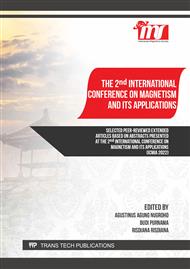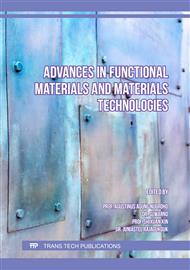[1]
A. K. Patra, S. K. Kundu, A. Bhaumik, and D. Kim, Morphology evolution of single-crystalline hematite nanocrystals: magnetically recoverable nanocatalysts for enhanced facet-driven photoredox activity, Nanoscale. 8 (2016) 365-377.
DOI: 10.1039/c5nr06509g
Google Scholar
[2]
A. S. Teja and P. Y. Koh, Synthesis, properties, and applications of magnetic iron oxide nanoparticles, Progress in crystall growth and characterization of material. 55 (2009) 22-45.
DOI: 10.1016/j.pcrysgrow.2008.08.003
Google Scholar
[3]
J. G. Catalano, Z. Zhang, P. Fenter, and M. J. Bedyzk, Inner-sphere adsorption geometry of Se (IV) at the hematite (100)–water interface, J. of Colloid Interface Sci. 297 (2006) 665-671.
DOI: 10.1016/j.jcis.2005.11.026
Google Scholar
[4]
F. Davar, H. Hadadzadeh, and T. S. Alaedini, Single-phase hematite nanoparticles: non-alkoxide sol–gel based preparation, modification and characterization, Ceram. Int. 42 (2016) 19336-19342.
DOI: 10.1016/j.ceramint.2016.09.104
Google Scholar
[5]
D. E. Fouad, C. Zhang, H. El-Didamony, L. Yingnan, T. D. Mekuria, and A. H. Shah, Improved size, morphology and crystallinity of hematite (α-Fe2O3) nanoparticles synthesized via the precipitation route using ferric sulfate precursor, Result Phys. 12 (2019) 1253-1261.
DOI: 10.1016/j.rinp.2019.01.005
Google Scholar
[6]
M. Tadic, D. Trpkov, L. Kopanja, S. Vojnovic, and M. Panjan, Hydrothermal synthesis of hematite (α-Fe2O3) nanoparticle forms: synthesis conditions, structure, particle shape analysis, cytotoxicity and magnetic properties, J. Alloys Compd. 792 (2019) 599-609.
DOI: 10.1016/j.jallcom.2019.03.414
Google Scholar
[7]
R. Vinayagam, S. Pai, T. Varadavenkatesan, M. K. Narasimhan, S. Narayanasamy, and R. Selvaraj, Structural characterization of green synthesized α-Fe2O3 nanoparticles using the leaf extract of Spondias dulcis, Surf. Interfaces. 20 (2020) 100618.
DOI: 10.1016/j.surfin.2020.100618
Google Scholar
[8]
W. Zhou, Y. Sun, Y. Han, P. Gao, and Y. Li, Recycling iron from oolitic hematite via microwave fluidization roasting and magnetic separation, Miner. Eng. 164 (2021) 106851.
DOI: 10.1016/j.mineng.2021.106851
Google Scholar
[9]
E. Paulson, and M. Jothibas, Significance of Thermal Interfacing in Hematite (α-Fe2O3) Nanoparticles Synthesized by Sol-Gel Method and its Characteristics Properties, Surf. Interfaces, 26 (2021) 101432.
DOI: 10.1016/j.surfin.2021.101432
Google Scholar
[10]
K. T. V. Rao, S. Souzanchi, Z. Yuan, and C. C. Xu, One-pot sol–gel synthesis of a phosphated TiO2 catalyst for conversion of monosaccharide, disaccharides, and polysaccharides to 5-hydroxymethylfurfural, New J. Chem. 43 (2019) 12483-12493.
DOI: 10.1039/c9nj01677e
Google Scholar
[11]
N. A. Spaldin, Magnetic materials: fundamentals and applications, Cambridge University Press (2010).
Google Scholar
[12]
R. C. Kambale, P. A. Shaikh, S. S. Kamble, and Y. D. Kolekar, Effect of cobalt substitution on structural, magnetic and electric properties of nickel ferrite, J. Alloys Compd. 478 (2009) 599-603.
DOI: 10.1016/j.jallcom.2008.11.101
Google Scholar
[13]
L. D. L. S. Valladares, A. B. Domínguez, L. L. Félix, J. B. Kargin, D. G. Mukhambetov, A.L. Kozlovskiy, and C. H. W. Barnes, Characterization and magnetic properties of hollow α-Fe2O3 microspheres obtained by sol gel and spray roasting methods, J. Sci.: Adv. Mater. Devices. 4 (2019) 483-491.
DOI: 10.1016/j.jsamd.2019.07.004
Google Scholar
[14]
X. Zheng, Y. Jiao, F. Chai, F. Qu, A. Umar, and X. Wu, Template-free growth of well-crystalline α-Fe2O3 nanopeanuts with enhanced visible-light driven photocatalytic properties, J. Colloid and Interface Sci. 457 (2015) 345–352.
DOI: 10.1016/j.jcis.2015.07.023
Google Scholar
[15]
P. Qiu, H. Yang, L. Yang, Q. Wang, and L. Ge, Solar water splitting with nanostructured hematite: The role of annealing-temperature, Electrochim. Acta. 266 (2018) 431-440.
DOI: 10.1016/j.electacta.2018.02.030
Google Scholar
[16]
E. R. Kumar, R. Jayaprakash, and T. Prakash, The effect of annealing on phase evolution, microstructure and magnetic properties of Mn substituted CoFe2O4 nanoparticles, J. Magn. Magn. Mater. 358 (2014) 123-127.
DOI: 10.1016/j.jmmm.2014.01.056
Google Scholar
[17]
R. Sefatgol and A. Gholizadeh, The effect of the annealing temperature on the microstructural, magnetic, and spin-dynamical properties of Mn–Mg–Cu–Zn ferrites, Physica B: Condens. Matter. 624 (2022) 413442.
DOI: 10.1016/j.physb.2021.413442
Google Scholar
[18]
A. Saraswathy, S. S. Nazeer, M. Jeevan, N. Nimi, S. Arumugam, V. S. Harikrishnan, and R. S. Jayasree, Citrate coated iron oxide nanoparticles with enhanced relaxivity for in vivo magnetic resonance imaging of liver fibrosis, Colloids Surf. B: Biointerfaces. 117 (2014) 216-224.
DOI: 10.1016/j.colsurfb.2014.02.034
Google Scholar
[19]
S. Srivastava, R. Awasthi, N. S. Gajbhiye, V. Agarwal, A. Singh, A. Yadav, and R. K. Gupta, Innovative synthesis of citrate-coated superparamagnetic Fe3O4 nanoparticles and its preliminary applications, J. Colloid and Interface Sci. 359 (2011) 104-111.
DOI: 10.1016/j.jcis.2011.03.059
Google Scholar
[20]
M. Tadic, M. Panjan, B. V. Tadic, S. Krajl, and J. Lazovic, Magnetic properties of mesoporous hematite/alumina nanocomposite and evaluation for biomedical applications, Ceram. Int. 48 (2022) 10004-10014.
DOI: 10.1016/j.ceramint.2021.12.209
Google Scholar
[21]
R. M. Cornell and U. Schwertmann, The iron oxides (2004).
Google Scholar
[22]
A. G. Roca and J. F. Marco, Effect of nature and particle size on properties of uniform magnetite and maghemite nanoparticles, J. Phys. Chem. C 111(2007) 18577-18584.
DOI: 10.1021/jp075133m
Google Scholar
[23]
A. M. El Sayed, Influence of the preparative parameters on the microstructural, and some physical properties of hematite nanopowder, Mater. Res. Express. 5 (2018) 025025.
DOI: 10.1088/2053-1591/aaad36
Google Scholar
[24]
S. Dutz, and R. Hergt, The role of interactions in systems of single domain ferrimagnetic iron oxide nanoparticles, J. Nano-Electron. Phys. 4 (2012) 02010.
Google Scholar
[25]
Z. N. Kayani, S. Arshad, S. Riaz, and S. Naseem, Synthesis of iron oxide nanoparticles by sol–gel technique and their characterization, IEEE Trans. Magn. 50 (2014) 1-4.
DOI: 10.1109/tmag.2014.2313763
Google Scholar



